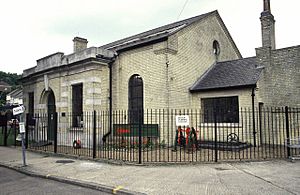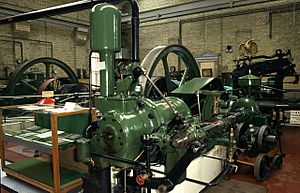Old Brook Pumping Station facts for kids
Quick facts for kids Old Brook Pumping Station |
|
|---|---|

Old Brook Pumping station, Chatham now a museum.
|
|
| Location | The Brook (road) Chatham, Kent ME2 9AQ |
| OS grid reference | TQ75996783 |
| Built | 1929 |
| Owner | Medway Council |
| Official name: Brook Low Level Pumping Station | |
| Reference no. | 1003407 |
| Lua error in Module:Location_map at line 420: attempt to index field 'wikibase' (a nil value). | |
The Old Brook Pumping Station is a special building in Chatham, Kent. It used to be a water pumping station, working from 1929 until 1980. Today, it's a cool museum where you can see how it all worked!
Contents
History of the Pumping Station
Chatham's Early Days
Way back in the 1500s, a big earth wall, called the 'Land Wall', was built between Rochester and Chatham Dockyard. This wall separated the Old River Bourne and its marshy lands from the main River Medway.
Between 1575 and 1610, a tide mill was built on what was then called The Brook. This mill used the power of the tides to grind grain.
By 1765, Chatham had grown a lot. The Brook river was covered over by a road. The old marshland became an area with many crowded homes and narrow streets. A famous writer, Charles Dickens, even lived at No. 18 The Brook when he was nine years old, between 1821 and 1823.
Dealing with Waste and Disease
The old river had been turned into culverts, which are like underground tunnels for water. People also used cesspits, which were pits for collecting waste. These were used to get rid of the town's waste.
Chatham's population grew from about 10,500 people in 1801 to nearly 37,000 by 1901. But the old drainage systems couldn't handle all the waste. This caused big health problems for the people, including outbreaks of diseases like Cholera. The River Medway also suffered, with fish and oyster populations decreasing.
In 1852, an expert named Edward Gotto looked into the town's health. His report showed how bad the diseases and sanitation were. This led to new work to improve Chatham's drainage and sewage systems, including building brick sewers and covered culverts.
Building a Modern System
In 1909, a tram line was built along the path of the old Brook River.
By 1920, the 'Rochester and Chatham Joint Sewerage Board' was created. Their job was to manage the sewage for both towns.
A huge project called the 'Rochester and Chatham Joint Main Drainage Scheme' was then planned. It cost a lot of money, about £650,000 in total. This new drainage system officially opened on December 4, 1928. It included a main sewer pipe running under New Road in Chatham, all the way to Motney Hill on the Rainham Marshes.
The Old Brook Pumping Station was a key part of this new system. Its job was to lift dirty water from the lowest parts of Chatham up to the main sewer pipe. It started working in September 1929.
From Pumping Station to Museum
In 1979, a new, modern pumping station with electric pumps took over the job of the Old Brook Pumping Station. This new station is still working today. The old station was then listed as an ancient monument, which means it's a very important historical site that needs to be protected.
After it stopped pumping water in 1979, the Southern Water Authority sold the Old Brook Pumping Station to Medway Council for just £1! It is now connected to the Rochester Guildhall Museum.
In 1984, a group called the Medway Industrial Archaeology Group started restoring the station. They worked hard to fix it up and then opened it to the public.
How the Pumping Station Worked
The pumping station has a large storage tank underground, about 28 feet deep.
During very heavy rain or floods, extra water and waste would be pumped through a special "Storm tower" directly into the River Medway. This waste would be very diluted by the rainwater, so it wouldn't cause too much harm.
The station had two large 14-inch Campbell diesel engines. These engines powered the pumps during storms and floods.
For normal amounts of wastewater, there were electric pumps. One electric pump, a 6-inch Blackstone Unchokeable Pump, could move 50,000 gallons of water every hour. There was also a backup pump just like it.
For bigger storms, there was an 8-inch Blackstone Unchokeable Pump that could move 100,000 gallons per hour, with another backup. If the storm was even bigger, the second 8-inch pump would automatically start. It would send the water through the Storm tower into a large culvert that led to the River Medway.
For the biggest storms, two powerful 14-inch Blackstone Unchokeable Pumps were used. These could move an amazing 250,000 gallons per hour! They were powered by 56-horsepower Campbell diesel engines.
What You Can See Today
The 'Medway Industrial Archaeology Group' takes care of the Old Brook Pumping Station with help from Medway Council.
When you visit, you can see an old Victorian printing press that was used to print the 'Rochester Gazette' newspaper. There are also models of windmills. Outside, you can see an old Aveling and Porter road roller, which was built by a famous factory in Strood.
The museum is open:
- June to September: Saturdays, 11am-3pm
- October to May: first Saturday of the month, 11am-3pm
Entry is free! You can also see steam engines and hot air engines.
The Brook Pumping Station is the main office for the Medway Industrial Archaeology Group (MIAG).


